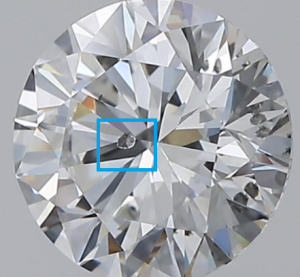Diamonds are one of the most valued and sought-after gemstones worldwide, celebrated for their pristine beauty and timeless elegance. However, the charm of these dazzling jewels lies not just in their external allure but also in their internal characteristics. These internal features, known as inclusions, tell a story about the diamond’s journey from deep within the earth to the beautiful jewel you see. One such inclusion is the ‘pinpoint’ – a feature that significantly impacts a diamond’s overall quality and value.

Unveiling the Diamond Inclusion: The ‘Pinpoint’
Pinpoint inclusions are tiny, dot-like internal or external features usually less visible to the naked eye, often requiring a 10x magnification loupe to observe. Their presence is a testament to the diamond’s natural formation process, wherein the carbon structure occasionally captures minute traces of other elements or minerals.
While pinpoint inclusions might be deemed as ‘flaws’ or ‘imperfections’ by some, they indeed serve as nature’s fingerprint on a diamond, affirming its authenticity. They are akin to birthmarks, each unique and differing from diamond to diamond. No two diamonds will have the same pattern or type of pinpoint inclusions, making each one truly unique.
Pinpoint Inclusions and Diamond Quality
Pinpoint inclusions can play a significant role in determining a diamond’s quality, as assessed by the Gemological Institute of America’s (GIA) diamond grading system. The system considers the size, number, position, color, and nature of the inclusions in a diamond to determine its clarity grade, with Flawless being the highest grade and Included being the lowest.
Diamonds with numerous or large pinpoint inclusions that are easily visible under 10x magnification are likely to be graded lower in terms of clarity. However, single, small pinpoints that are hard to see even under magnification might not impact the clarity grade significantly.
The Art of Identifying Pinpoint Inclusions
The art of identifying pinpoint inclusions involves a meticulous examination of a diamond under a gemological microscope. Experienced gemologists can not only spot these inclusions but can also infer valuable information about the diamond’s formation and history from them.
Pinpoint inclusions are categorized into light and dark pinpoints, where light pinpoints are tiny cavities filled with air, and dark pinpoints are specks of foreign minerals. Furthermore, the distribution of pinpoints – whether they are scattered or clustered – also offers valuable insights about the diamond’s growth conditions.
Pinpoint Inclusions: Significance in the Diamond Industry
In the diamond industry, pinpoint inclusions hold significant importance in differentiating natural diamonds from synthetic ones. Natural diamonds often contain pinpoints, while synthetic or lab-grown diamonds typically do not, as they are grown under controlled conditions.
Pinpoint inclusions also play a vital role in diamond cutting. Diamond cutters take into consideration the size, location, and type of pinpoint inclusions while shaping and polishing a diamond to minimize their visibility and maximize the diamond’s brilliance and fire.
Embracing the Pinpoint Inclusion
Pinpoint inclusions, despite their microscopic size, hold immense significance in a diamond’s journey. They not only affirm the diamond’s natural origin but also contribute to its unique character and story. The understanding and appreciation of these tiny inclusions enable us to truly comprehend the diamond in its entirety, thereby deepening our appreciation for these remarkable gifts from nature.